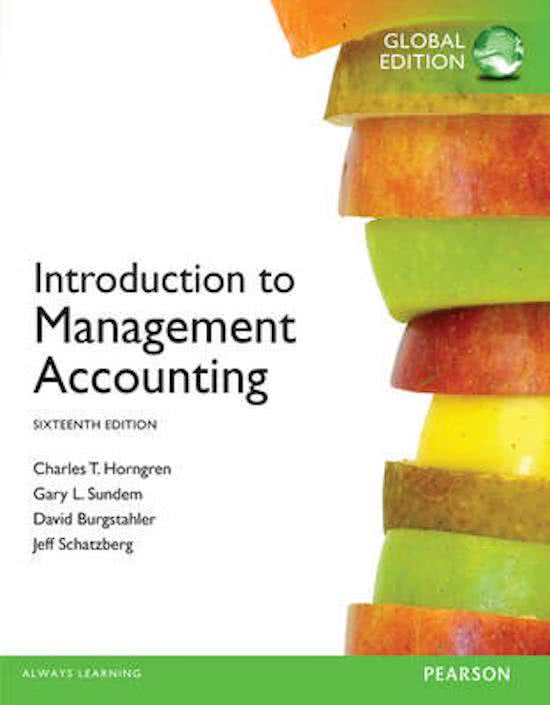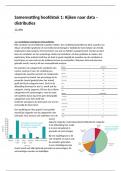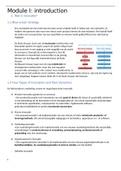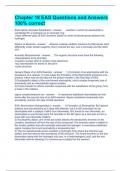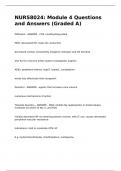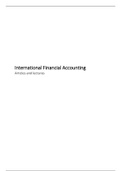Summary finance
Training 1
Accounting information is used in decision making for planning and control.
Planning:
Describes HOW the organization will achieve its objectives.
Control:
Is the process of implementing plans and evaluating if objectives are achieved.
Accounting information systems collect and process financial information about an
organization and report that information to decision makers.
The accounting system collects and processes financial information about an organization
and reports that information to decision makers.
The accounting system provides financial accounting reports which include periodic financial
statements and related disclosures to external decision makers. These decision-makers
include investors, creditors, suppliers, customers, union representatives, and all other
interested parties.
The accounting system also provides managerial accounting reports including detailed plans
and continuous performance reports. These reports are used by internal decision makers
,throughout the organization to make decisions about pricing, production, quality, and
numerous other day-to-day activities.
Balance sheet
equivalent of a “snapshot or photo” of the company at one point in time.
Purpose:
To show how the values are distributed in the company at that particular point in time.
- The amount of assets
- Liabilities
- Stockholders’ equity
Income statement
is like a “video” showing the history of what has happened to the company over a period
of time.
Purpose:
To calculate the results (revenues – the expenses) that the company has achieved within the
year of operation (resulting in profit or loss)
The accounting equation:
“living” balance sheet (not in an on-line setting)
- Each volunteer receives and account and decides to be on the Debit or Credit side.
- Two volunteers represent Debit and Credit
- Two other volunteers check if all “living” accounts are in the right place and create
balance
- Volunteers decide on changes if needed
, Typical account titles for the balance sheet:
Assets: liabilities:
Short term short term
- Cash - accounts payable
- Short-term investment - accrued expenses
- Accounts receivable - notes payable
- Notes receivable - taxes payable
- Inventory (to be sold) - unearned revenue
- Supplies long term
- Prepaid expenses - long term loan
Long term - mortgage
- Long-term investment
- Equipment stockholders’ equity
- Buildings - contributed capital
- Land - retained earnings
- Intangibles
Intangibles assets: have no physical existence (patents, trademarks, goodwill)
Notes Receivable: are written promises that require another party to pay the business (loan
to employee)
Notes Payable: amount borrowed+ interest rate associated with the borrowing
Unearned Revenue: Customer pays in advance for services that have not yet been
performed by the recipient of the payment
Revenues – expenses = net income
Typical account titles for the income statement:
Expenses revenues
- Cost of goods sold - sales revenue
- Wages expense - fee revenue
- Rent expense - interest revenue
- Interest expense - rent revenue
- Depreciation expense
- Advertising expense
- Insurance expense
- Repair expense
- Income tax expense
The first category, or element, is revenues. Companies earn revenues from the sale of goods
and services to customers. A few examples of revenues include sales revenue, interest
revenue and rent revenue.
Expenses represent the dollar amount of resources used to earn revenues during the period.
Examples are wages expense, rent expense, and advertising expense.
Training 1
Accounting information is used in decision making for planning and control.
Planning:
Describes HOW the organization will achieve its objectives.
Control:
Is the process of implementing plans and evaluating if objectives are achieved.
Accounting information systems collect and process financial information about an
organization and report that information to decision makers.
The accounting system collects and processes financial information about an organization
and reports that information to decision makers.
The accounting system provides financial accounting reports which include periodic financial
statements and related disclosures to external decision makers. These decision-makers
include investors, creditors, suppliers, customers, union representatives, and all other
interested parties.
The accounting system also provides managerial accounting reports including detailed plans
and continuous performance reports. These reports are used by internal decision makers
,throughout the organization to make decisions about pricing, production, quality, and
numerous other day-to-day activities.
Balance sheet
equivalent of a “snapshot or photo” of the company at one point in time.
Purpose:
To show how the values are distributed in the company at that particular point in time.
- The amount of assets
- Liabilities
- Stockholders’ equity
Income statement
is like a “video” showing the history of what has happened to the company over a period
of time.
Purpose:
To calculate the results (revenues – the expenses) that the company has achieved within the
year of operation (resulting in profit or loss)
The accounting equation:
“living” balance sheet (not in an on-line setting)
- Each volunteer receives and account and decides to be on the Debit or Credit side.
- Two volunteers represent Debit and Credit
- Two other volunteers check if all “living” accounts are in the right place and create
balance
- Volunteers decide on changes if needed
, Typical account titles for the balance sheet:
Assets: liabilities:
Short term short term
- Cash - accounts payable
- Short-term investment - accrued expenses
- Accounts receivable - notes payable
- Notes receivable - taxes payable
- Inventory (to be sold) - unearned revenue
- Supplies long term
- Prepaid expenses - long term loan
Long term - mortgage
- Long-term investment
- Equipment stockholders’ equity
- Buildings - contributed capital
- Land - retained earnings
- Intangibles
Intangibles assets: have no physical existence (patents, trademarks, goodwill)
Notes Receivable: are written promises that require another party to pay the business (loan
to employee)
Notes Payable: amount borrowed+ interest rate associated with the borrowing
Unearned Revenue: Customer pays in advance for services that have not yet been
performed by the recipient of the payment
Revenues – expenses = net income
Typical account titles for the income statement:
Expenses revenues
- Cost of goods sold - sales revenue
- Wages expense - fee revenue
- Rent expense - interest revenue
- Interest expense - rent revenue
- Depreciation expense
- Advertising expense
- Insurance expense
- Repair expense
- Income tax expense
The first category, or element, is revenues. Companies earn revenues from the sale of goods
and services to customers. A few examples of revenues include sales revenue, interest
revenue and rent revenue.
Expenses represent the dollar amount of resources used to earn revenues during the period.
Examples are wages expense, rent expense, and advertising expense.

